Streptocarpus meyeri
Streptocarpus meyeri B.L.Burtt
Family: Gesneriaceae
Common names: Cape primrose, wild gloxinia (Eng.)
Introduction
A lovely, neat, pretty species of Streptocarpus that has flat-growing, rough leaves and delicate flowing stems presenting white flowers with a violet blush and two light yellow stripes in the mouth of each flower.
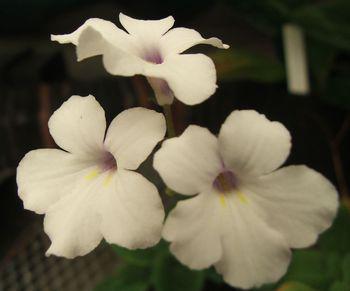
Description
Description
This perennial has a rosulate cluster of 3 to 10, flat-growing leaves, all arising just slightly above the ground. The elliptically broad, 200 × 75 mm, rough, green leaves have shallow toothed margins and can become almost shaggy in appearance as they get older.
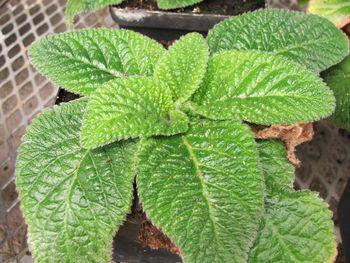
Delicate flower stems up to 200 mm long, arise from the base of each leaf’s midrib and can number as few as 2 or as many as twelve during the growing season. Clusters of trumpet-like, five-lobed, white flowers, sometimes pale violet on the outside at the base of the flower, occur in late summer and autumn, from January to April.
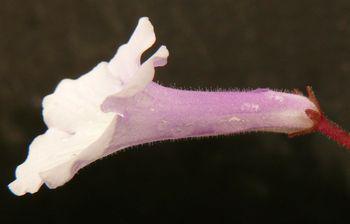
The flower usually has a single or split, yellow stripe on the floor of the corolla tube, with the violet colour within the flower throat and at the noticeably narrow mouth of the flower, varying from being absent, to pale violet, to a deep vibrant violet colour, with speckles or spreading streaks extending out along the petals. Fruits are spirally twisted, slender, pod-like capsules, filled with masses of minute seeds.
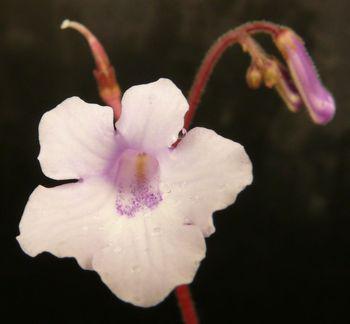
Conservation Status
Status
Streptocarpus meyeri is assessed as Least Concern (LC).

Distribution and habitat
Distribution description
Occurs naturally in more exposed habitats on mountainous aspects yet still protected and shaded within rock cracks and fissures, or on south-facing rock walls and steep soil slopes in the Baviaanskloof Mountains in the Eastern Cape and in Mpumalanga Province.

Derivation of name and historical aspects
History
The name Streptocarpus is derived from the Greek words, streptos, meaning ‘twisted’ and, carpus, meaning ‘fruit’, which describes the spirally twisted seedpods characteristic of these plants. The species is named for Ernst Heinrich Friedrich Meyer or Carl Anton Meyer, both of whom were 19th century German botanists.
Brian Laurence Burtt, who named and described this species, was an English botanist and taxonomist who is known for his substantial contributions to the family Gesneriaceae. He first worked at the Royal Botanic Gardens, Kew, and then at the Royal Botanic Garden Edinburgh in a career that spanned 74 years. Burtt made numerous field trips to South Africa and elsewhere in the world from which he described a total of 637 new plant species, of which the greater number were Gesneriaceae.
Streptocarpus belongs to the same family, Gesneriaceae, as do the well-known African violets and gloxinias that are grown as popular pot plants all over the world. This is a large family of mostly tropical and subtropical herbs, with ± 130 genera, and ± 2 900 species worldwide. There are 8 genera in Africa, with the single genus, Streptocarpus, in South Africa and it has ± 51 species. The family is named after Konrad Gesner. He was a Swiss scholar, and in 1963, 30 years after his death, his name was given to this family.
Ecology
Ecology
Gesneriaceae are often epiphytic (growing on trees) or lithophytic (growing on rocks).
Streptocarpus flowers often have nectar guidelines that guide would-be pollinators (birds, long-tongued flies and moths, butterflies and bees) to the nectar. The plants can easily be cross pollinated with other species, but in many instances, are self-pollinated. The very small seeds are dispersed by wind.
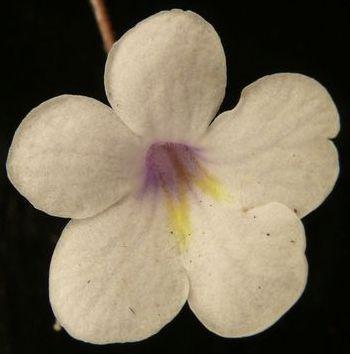
Uses
Use
Although this species is a challenge to find and cultivate, there are many easy-to-grow Streptocarpus hybrids in all shapes and sizes, with really striking flower colours and forms, which make very popular indoor plants. Streptocarpus flowers also make excellent cut flowers, especially the long-stemmed varieties, as they last very well in the vase.
Growing Streptocarpus meyeri
Grow
Streptocarpus meyeri is a plant that is seldom seen in gardens due to its unavailability in the trade and because it can be challenging to grow in home garden conditions.
Many species of Streptocarpus make beautiful pot plants and garden plants for shady areas, but this species would do better as a pot plant, rather than planted out in the garden. Ensure a warm spot with good light but no direct sunlight, somewhere on your patio or in the house.
Streptocarpus in general are all very sensitive to direct light, and are scorched easily by the sun, but flower poorly in deep shade. Light shade with good ventilation is best for growing healthy plants with plenty of flowers.
Watering Streptocarpus should be done with care. It is very important that the plants should not be over-watered to prevent rotting and fungal problems. They have quite shallow root systems as in nature and they often thrive in very little soil, so allow them to get quite dry between watering. In fact, they like being allowed to wilt slightly between each watering, and they have the ability to recover very well from this. Be aware that severe wilting can be a sign of root rot caused by over-watering, so check the soil to see that this is not the case.
Avoid wetting this plant’s leaves by watering from the base; pour water into the pot’s tray instead, so that the plant and soil can absorb what is required from there, but once the plant has taken up what it needs, discard any water remaining. During the warm summers when they are actively growing, the plants need regular watering, but note that most Streptocarpus ‘rest’ during winter and this slight dormancy will cause them to need very little water during this time, so be sure to reduce the amount given from autumn onwards until spring.
The two main things to remember when growing Streptocarpus, are that they do not like soil that is too wet, and they do not like heat from direct sunlight.
Pruning: the older leaves will regularly die off, especially in winter. In spring they will be replaced with new leaves as part of the normal growth cycle of streptocarpus. To keep the plants looking attractive, regularly remove all yellowing, brown, unhealthy, or dying leaves, by snipping them off at their base. The tips of the leaves also often slowly die back to an abscission line as they get older or when stressed by drought or low temperature or when over wintering. This unattractive tip can be cut off/removed without limiting the growth of the leaf, as it would naturally shed this anyway and continue with new growth from the base of the leaves. Removing spent flowers can often stimulate a second flush of flowers, so nip off each flower as they fade, then snip off the whole stem at the base once the last flower has dropped. Unless you wish to collect the seeds, then leave the flowers to form fruit capsules.
Feeding: do feed regularly during the growing season with liquid foliar feeds or a general fertilizer or a flower-enhancing fertilizer is recommended.
Planting: repot once the plant’s roots appear at the bottom of the pot.
Pests and diseases: the most common afflictions are aphids and mealy bug. Mottled leaves indicate an infestation with leafhoppers or sometimes red spider mite, these sap-sucking insects can spread viruses. White spots on flowers and leaves in combination with buds that do not open, indicate an infestation with thrips. Holes in leaves are most often made by caterpillars. These can all be controlled by either applying a commercial insecticide, or with cultural pest removal methods, or predatory biological pest controls. Sometimes it is as simple as handpicking off the pest, where appropriate, as well as improving hygiene and increasing ventilation.
Propagation: is best done in spring which is the start of the growing season, either by clump division, seed sowing or leaf cuttings.
Streptocarpus can easily be grown from seed. When sowing the seeds, mix a pinch of the dust-like seeds with a small amount of sand to assist with spreading the seeds evenly. Use a well-drained, spongy medium that is not too coarse, at Kirstenbosch National Botanical Garden we use equal parts peat and compost. Cover with a very thin covering of sand, keep out of direct sun, but in warmth, and water regularly with a fine spray. Germination usually takes 3 to 4 weeks, and do not allow the seedlings to dry out. Plant the seedlings into small pots only once they are quite big and strong. Transplant the young plants again into bigger pots when the roots have filled the small pots.
Plants that have grown quite large can also be divided as a method of increasing them; do this in early spring and repot to grow on. When doing division, break multi-crown clumps into pieces, ensuring each has some of the root system and plant up.
Streptocarpus can be propagated from a single leaf and the best results are from leaf cuttings taken in spring and early summer. Select healthy youngish leaves from the center of the plant and cut off using a sharp knife or blade. Remember that the most active region of the leaf is near the base where the growing region (meristem) is present and so this area will yield the best rooting results. If it is a small leaf, insert the cut end of the leaf into a rooting hormone and then into the medium. Larger leaves can be cut into 3 cm strips. Always take note of which way is the leaf cutting should be orientated before dipping into a rooting hormone and place firmly into the medium, but not too deep, as this will encourage rot. Alternatively, cut along either side of the midrib and treat in the same manner. A variety of mediums can be used as long as they are well drained. Sand, bark, palm fibre and polystyrene or vermiculite in different ratios are all suitable. At Kirstenbosch we use 40% bark, 40% fine leca and 20% vermiculite, and 20% riversand. Water the medium well and treat with a suitable fungicide before using. Depending on the species, plantlets will form along the base of the cut within 1 to 3 months.
When the plantlets are well established, the old leaf can be teased out from the medium and the plantlets potted up into a rich well-drained soil mixture, usually between 6 and twelve months. Streptocarpus thrive in a nutritious, well-aerated medium with ample drainage. A mix of equal parts loam, sand, peat moss and well-rotted compost is ideal.
As they do not have deep roots, they often do better in shallow pots. Mature plants can lose their vigor after 3 to 5 years, and propagation as described above, can be used to replace them with younger plants.
Mealybug, aphids and caterpillars are the most troublesome pests of streptocarpus, though none severely. Caterpillars can either be hand collected or sprayed with a suitable poison, aphids can be sprayed, or removed carefully by running a thumb and forefinger along the flower stems- where they usually occur. If mealybug is found on any part of the plant, quickly remove the affected parts and treat with a suitable pesticide. Kirstenbosch has had great success in managing infestations by using Biological control with the natural predators of mealybug.
Fungal infections are also a cause for concern; if fungus is found on any part of the plant, remove the affected parts and treat with a suitable fungicide.
Streptocarpus are usually only prone to pests and diseases when they not being treated or grown correctly, any plant that is stressed is more likely to come under attack. So avoid the following to reduce the occurrence of problems- overwatering, underfeeding, rootbound plants, lack of good air movement/circulation.
References
- Burtt, B.L. & Hilliard, O.M. 1971. Streptocarpus, an African plant study. University of Natal Press, Pietermaritzburg.
- Daniels, F. & Truter, J. 2005. Streptocarpus meyeri B.L.Burtt. National Assessment: Red List of South African Plants version 2015.1. Accessed on 2016/05/29
- Goldblatt, P. & Manning, J. 2000. Cape Plants. A conspectus of the Cape flora of South Africa. Strelitzia 9. National Botanical Institute, Pretoria & Missouri Botanical Garden, Missouri.
- Leistner, O.A. (ed.). 2000. Seed plants of southern Africa: families and genera. Strelitzia 10. National Botanical Institute, Pretoria.
Credits
Cherise Viljoen
Kirstenbosch National Botanical Garden
May 2016
Plant Attributes:
Plant Type: Perennial
SA Distribution: Eastern Cape, Mpumalanga
Soil type: Loam
Flowering season: Late Summer, Autumn
PH: Neutral
Flower colour: White, Yellow, Mauve/Lilac
Aspect: Shade
Gardening skill: Challenging
Special Features:
Horticultural zones











Rate this article
Article well written and informative
Rate this plant
Is this an interesting plant?
Login to add your Comment
Back to topNot registered yet? Click here to register.